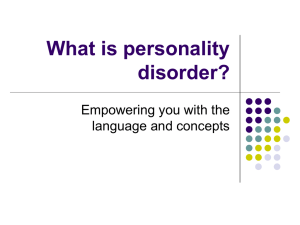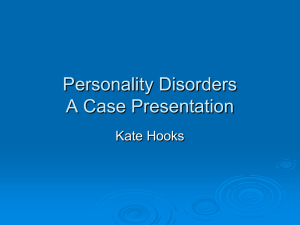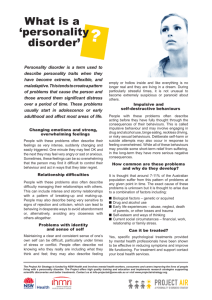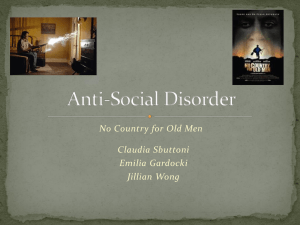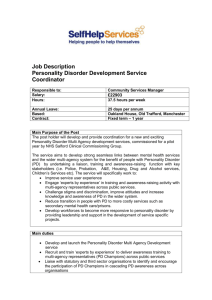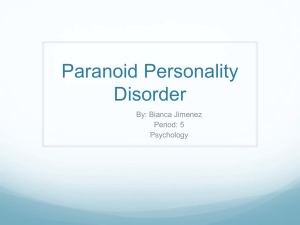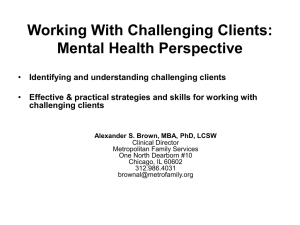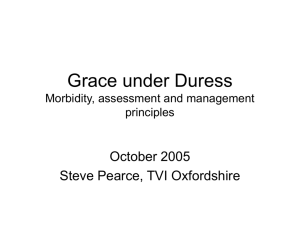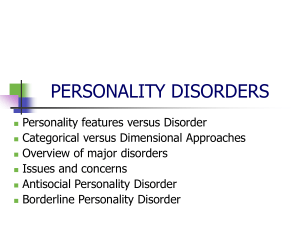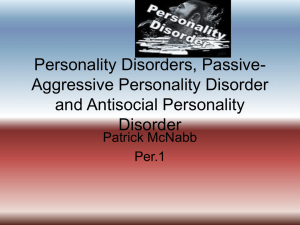Lecture 10
advertisement
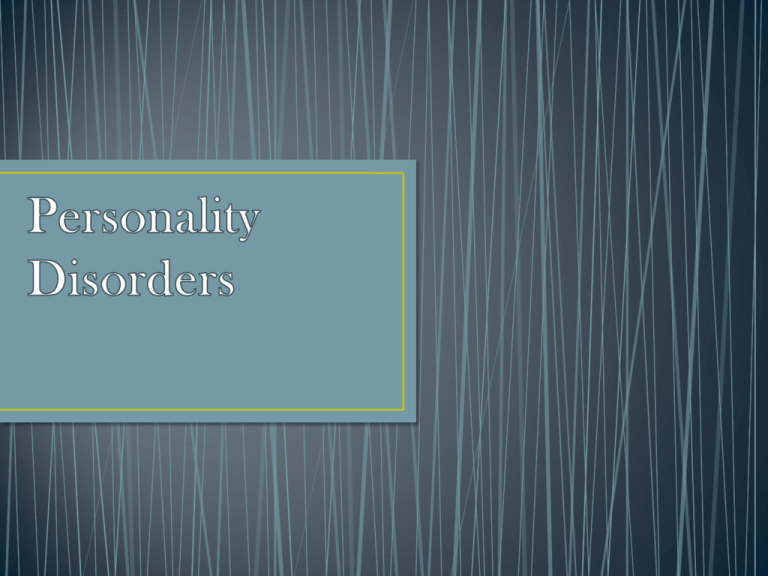
• personality disorder: enduring patterns of perceiving, relating to and thinking about the environment and oneself. . . . that are inflexible and maladaptive - cause functional impairment or subjective distress • • • • chronic originate in childhood – continue as an adult may or may not distress the person with the disorder listed on Axis II of the DSM-IV • Cluster A: odd or eccentric beliefs • Paranoid p.d. • Schizoid p.d. • Schizotypal p.d. • Cluster B: dramatic, emotional, erratic • Antisocial p.d. • Borderline p.d. • Narcissistic p.d. • Histrionic p.d. • Cluster C: fearful disorders • Obsessive-Compulsive p.d. • Avoidant p.d. • Dependent p.d. • failure to conform to social norms • deceitfulness • impulsivity • aggressiveness – repeated fights or assaults • disregard safety of self and others • irresponsibility • lack of remorse • psychopathy: focuses on personality traits – some psychopaths do not have legal or severe interpersonal problems • • • • • • Glibness/superficial charm Grandiose sense of self-worth Prone to boredom/need stimulation Pathological lying Conning/manipulative Lack of remorse • Crowe • “adopted away” children of felons had significantly higher criminality • Eysenck & Eysenck criminality concordance rate - Monozygotic – 55% - Dyzygotic – 13% • under-arousal hypothesis: abnormally low level of cortical arousal • fearlessness hypothesis: higher threshold for experiencing fear than others • differences in autonomic arousal • galvanic skin response (GSR): measure of sweating and autonomic arousal • coercive family process – parents give into children to avoid problems • trauma • SES disadvantage • after age 40 – the psychopath begins to “burn out” • frantic efforts to avoid real or imagined abandonment • unstable and intense interpersonal relationships • unstable self-image or sense of self • impulsivity in ways that are harmful • recurrent suicidal behavior or self-mutilating • affective instability • chronic feelings of emptiness • inappropriate anger • transient paranoid ideation – severe dissociation • Based on a bio-social theory of BPD. Problems w/ Emotionally Vulnerable Person An invalidating Environment 1. Ability to Understand & label feelings. 2. Coping skills. 3. Emotion modulation. • medications: • tricyclic antidepressants and lithium • dialectical behavior therapy (DBT) – Linehan • help cope with stressors that trigger suicidal behaviors – learn to identify and regulate emotions • histrionic personality disorder: express emotions in an overly dramatic fashion – often seductive in appearance - speech is vague, impressionistic • Lilienfeld and colleagues • Histrionic overlaps with antisocial p.d. – females histrionic – while males antisocial • narcissisic personality disorder: pervasive pattern of grandiosity, need for admiration, and lack of empathy • Kohut – caused by a lack of empathic “mirroring” by parents early in development – child is fixated on self-centered grandiose stage of development • paranoid personality disorder: excessively mistrustful and suspicious of others without justification • schizoid personality disorder: pattern of detachment from social relationships combined with a limited range of emotions in interpersonal situations • schizotypal personality disorder: social isolation combined with odd or eccentric beliefs • preoccupied with details, rules, lists, order, or schedules – point of activity becomes lost • excessively devoted to work and productivity to exclusion of friends and leisure • inflexible about matters of morality • can’t discard worn out items • can’t delegate tasks to others • miserly spending • rigidity and stubborn • avoidant personality disorder: pattern of social inhibition, feelings of inadequacy, and hypersensitivity to negative evaluation • behavioral intervention techniques for anxiety and social skills problems • systematic desensitization • behavioral rehearsal • dependent personality disorder: excessive need to be taken care of that leads to submissive and clinging behavior and fears of separation • agree with others even when they disagree to avoid rejection – cling to relationships

